13 Ingredients To Make Your Cauliflower Mash Extra Creamy
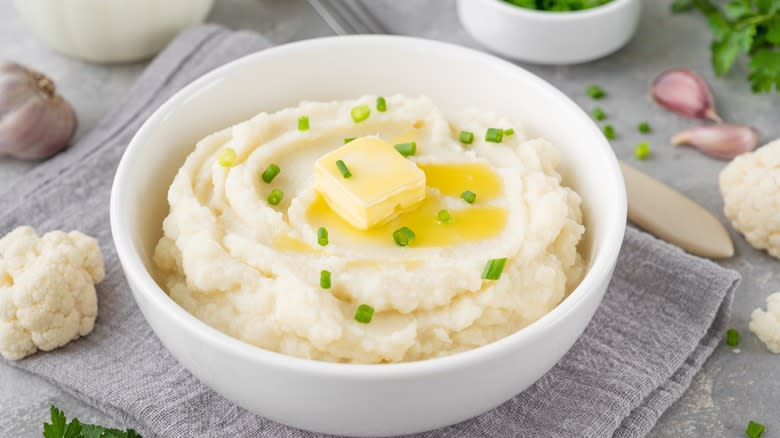
Before we even get into mashed cauliflower, it's critical to recognize its inspiration comes from the reign of the potato, king of mashed vegetable side dishes. Mashed potato is a creamy comfort food, a Thanksgiving staple, and the foundation of many delicious meals. It's a dish that can transform into fried potato fritters or fluffy rolls when you find yourself in the enviable position of having leftover mashed potatoes.
However, shaking it up with a creamy cauliflower mash is a delectable way to bring some variety to your table. Cauliflower is packed with tons of nutritional benefits and closely mimics the fluffy texture of your standard potato mash. And just like the potato, it's incredibly versatile. You can roast it for a smoky depth or steam or boil it. You can even cut your prep time in half using leftover riced cauliflower to make your mash.
Because cauliflower doesn't have potatoes' starch content, you'll need to make some adjustments to achieve the same creamy consistency as its tuber brethren. For extra creamy mashed cauliflower, reach for one (or more) of these ingredients.
Read more: 23 Types Of Potatoes And When To Use Them
Cream Cheese
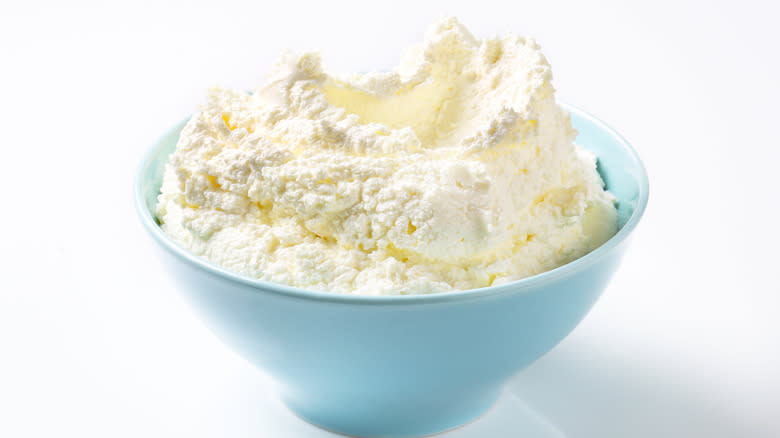
Just as potatoes dominate the holiday table landscape, cream cheese rules over breakfast. So why not harness the slight tang and rich texture of cream cheese to make your mashed cauliflower smooth and luscious?
Cream cheese comes in different levels of fat. The higher the fat content, the more indulgent your mash, but even the lower-fat varieties will impart a noticeable uptick in flavor and texture. If you don't want to eliminate fat entirely but aren't solid on the idea of dropping two tablespoons or more of full-fat cream cheese into your cauliflower, look for Neufchâtel cheese instead. Named for the region in France, where it was first produced in the sixth century, this creamy spread has a similar tang but 10% less fat than cream cheese.
To incorporate this dreamy ingredient, use one-quarter cup of cream cheese per medium head of cauliflower. Mix the cream cheese with a splash of milk and a tablespoon of butter in a food processor before adding your cooked, chopped cauliflower. Blend until smooth; season with salt and pepper to taste.
Heavy Cream
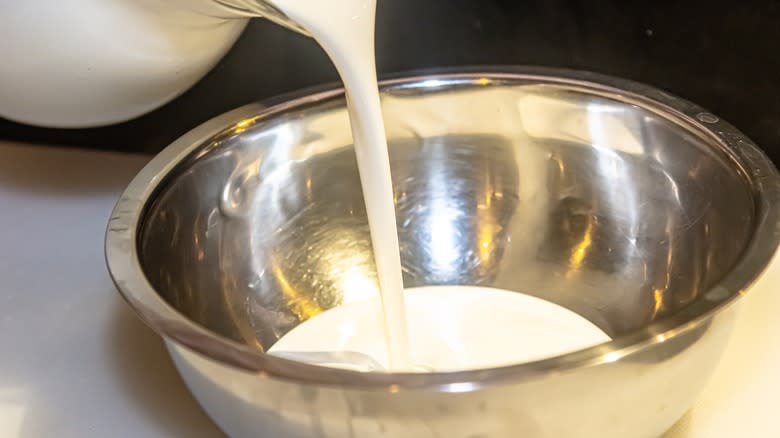
Just like bacon, heavy cream makes most things better, and this is true when it comes to mashed cauliflower. This ingredient works especially well for diners who don't like the taste of cauliflower but want an alternative to potatoes — the extra fat coats the palate and covers up the more earthy flavors that some do not prefer.
When confronted with the dairy options of heavy cream and heavy whipping cream, honestly, both will serve the purpose just fine. Heavy cream must have at least 36% fat to bear the label; whipping cream's fat content usually lands between 30 and 36%. If you want to indulge without going overboard, choose heavy whipping cream instead, although the difference in fat content may not be noticeable.
Don't be shy about adding the cream as you blend your cooked cauliflower, but don't go overboard. Too little, and your final product will be gritty, but too much, and you'll be having soup. Generally speaking, you can substitute heavy cream for milk in a 1:1 ratio but add it gradually to get the texture you like. A little pinch of nutmeg is a good idea here, and pass the black pepper grinder at the table.
Butter
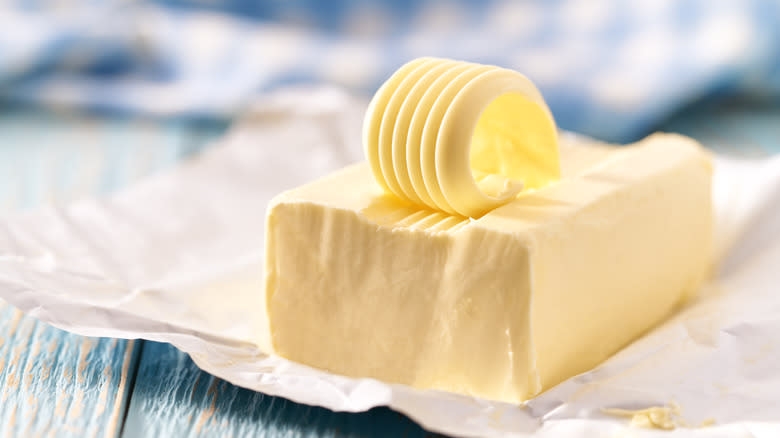
Butter, that glorious pat of yellow, is right at home in mashed cauliflower. The problem is some people skimp on this ingredient when making cauliflower mash and wonder why their final product is dry.
The key is to choose the correct butter and add it at the proper time (and in the correct form). Regular supermarket butter -- salted or unsalted -- works just fine, but European-style butter is the move for silky smooth cauliflower mash. Compared to American-style butter, this butter has a higher percentage of fat and a slower churning time that bumps up the flavor. If you love the flavor of butter and want it to be prominent, choose European butter. Otherwise, supermarket butter is a solid (and more affordable) choice.
Don't make the mistake of melting your butter before you add it. If it's cooked too long, the milk solids will separate and leave you with a greasy slick. Soften the butter to room temperature and blend with your other ingredients before adding the cauliflower.
Sour Cream
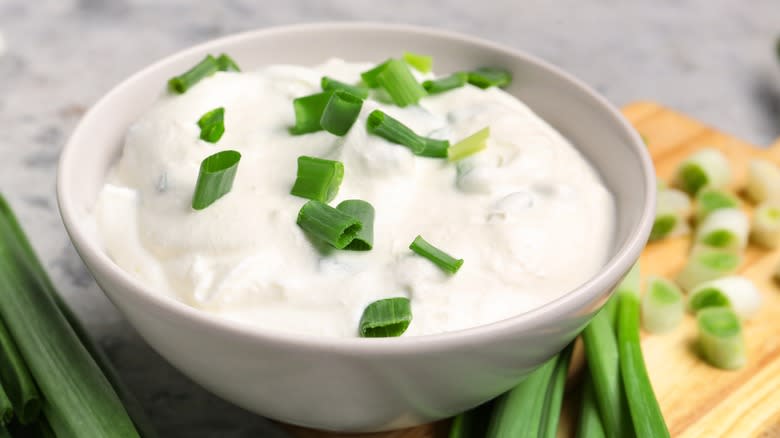
Sour cream is a delicious topping for mashed potatoes, so it's no surprise that it enhances the flavor and texture of mashed cauliflower. Sour cream's tart, bright flavor provides the perfect foil to other rich ingredients (like butter or heavy cream), bursting through to pick up even the most subtle notes in the cauliflower. Sour cream can also firm up a mash that has become a little sloppy after the injudicious addition of milk or cream.
Because low-fat sour cream may contain extra ingredients like additives to help it mimic the texture of full-fat, the best option may be to go with full-fat versions. You can use all sour cream to make your mash, but that might result in an overwhelming tang and richness that becomes unbearable after just a few bites. Create a simple mixture of sour cream and a splash of milk or heavy cream, and blend with butter and pepper before adding your cooked cauliflower. Sour cream plays well with green onions; add them to the top of your mash for a beautiful zingy bite.
Parmesan Cheese
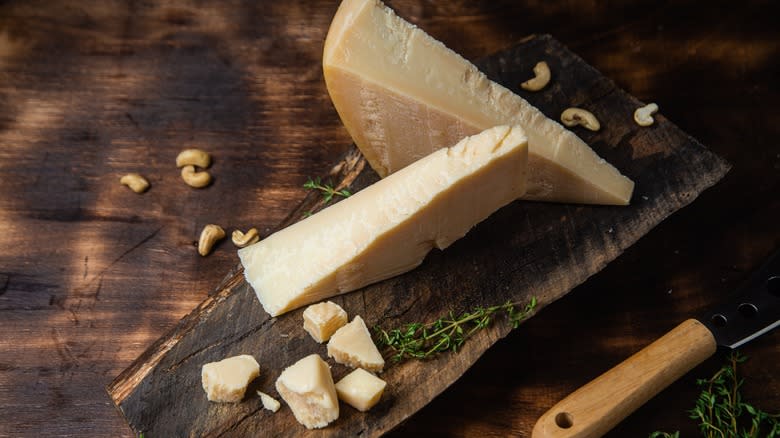
Parmesan cheese is a delicious, salty pairing for cauliflower that does double duty: Not only does it add the perfect nutty flavor to your dish, but it also helps to thicken a runny mash. Even if you didn't plan on adding it, you might find yourself reaching for that wedge in the back of the cheese drawer if you overdo it on other liquid ingredients (or forget to drain your cooked cauliflower completely).
Keep in mind that although convenient, pre-grated Parmesan cheese (or the kind that comes in that shelf-stable green plastic container) often has added fillers and preservatives that can change both the flavor and the texture of your cauliflower mash.
Don't let that happen to you. Grab a wedge of parm and grate it as you need it. Generally, a half-cup of Parmesan per large head of cauliflower will do the trick for flavor and creaminess. Add as much as you like, but remember that Parmesan is salty. Taste and adjust, adding salt last. Like potatoes, cauliflower can handle a lot of salt, but too much is never a good thing.
Olive Oil

Olive oil is an antioxidant-rich fat that ranges in flavor and color from intensely green and herbaceous to golden yellow and neutral. Because it's not cooked when added to cauliflower mash, it retains its unique flavor even as it smooths out the mash and creates a creamy, rich texture.
Olive oil is especially suitable for vegans and people adhering to a paleo diet, as a luxe-tasting side dish can be created with just two ingredients: olive oil and cauliflower. But you'll have to use the proper technique to make it work. Chop cauliflower into florets and boil or steam until soft. Drain and pat dry — the olive oil won't blend properly if the cauliflower is wet. Start using just a tablespoon of cauliflower in a food processor and pulse before processing on high. If you need more, add it a little at a time. Season as you like, but this preparation really highlights the flavor of cauliflower.
Although olive oil supposedly lowers heart disease risks, it's still loaded with calories. A tablespoon has about 120 calories, and those add up. If you're minding your macros, choose the richest, most flavorful oil you can afford and use a light hand.
Greek Yogurt
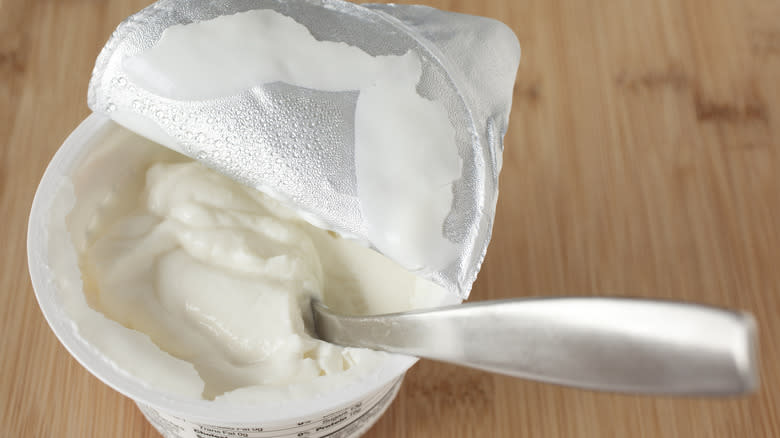
Greek yogurt isn't just one layer in your protein-packed breakfast parfait. It's sour cream's next of kin, a great substitute for when you need a bit of creamy tang. If you're in a pinch, regular yogurt would work for texture, but there are significant differences between Greek and regular yogurt. Greek yogurt is thicker than regular yogurt and tastes more sour. While both are nutritious, regular yogurt lasts longer after opening due to its higher acid content.
Use Greek yogurt the same way you would sour cream. There are slight differences in flavor and texture, so taste as you add the yogurt to make sure you're on board with the flavor profile. If it's a little too much tang for your taste, soften the blow with a splash of milk or cream.
Don't have any Greek yogurt on hand? Make your own by draining regular yogurt for a few hours (overnight is best). Add plain yogurt to muslin or cheesecloth and suspend it over a bowl in the fridge. Allow to drain, then use the thick yogurt that remains. Don't throw out the whey — it's perfect in smoothies or anywhere you'd use buttermilk.
Cottage Cheese
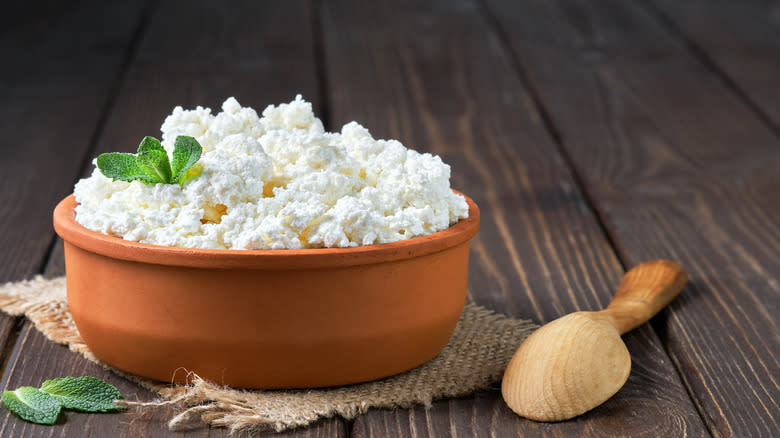
Cottage cheese has been having a minute for a while now. The savory, protein-packed curds are featured in everything from pepperoni pizza bowls to chocolate pudding. Blending the cottage cheese makes it a more versatile ingredient, and this is absolutely true when it comes to making the creamiest mashed cauliflower ever.
To use cottage cheese for creamy mashed cauliflower, blend it until smooth before combining and blending with cooked, drained cauliflower. The additional blending time makes the cottage cheese even more airy and lightens up the texture of the mash even as it smooths it out. Season carefully with just a touch of salt and copious black pepper.
Beyond the texture of cottage cheese (and the flavor that is all but neutralized by cauliflower's earthiness), the protein payback is huge. A half-cup serving of cottage cheese has roughly 12 grams of protein, and low-fat versions deliver the same protein with fewer calories and the same amount of calcium, B12, and other vitamins.
Chicken Broth
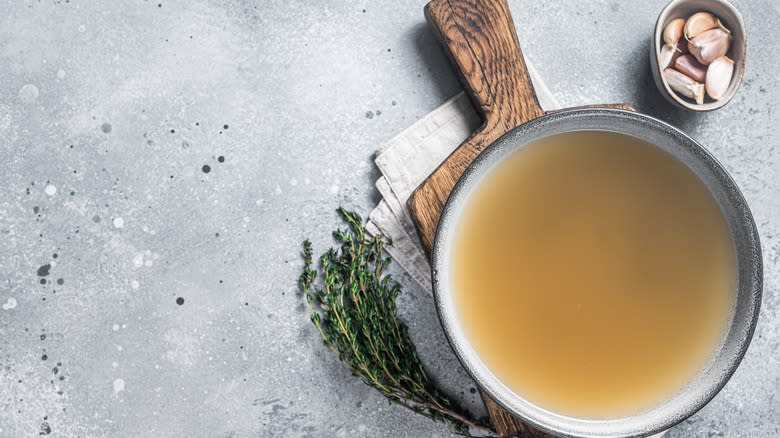
If you have the opportunity to add more flavor to mashed cauliflower, take it. Substituting chicken stock or broth for milk or heavy cream is one way to bring a richer flavor to the dish while helping create a creamy consistency. This is also an excellent ingredient for creating a silky texture without dairy.
You'll want to gently warm your stock before blending it with the cauliflower. The best stocks have a gelatinous texture when cold, which can be unpleasant, but this means ample collagen is present. Collagen is the inside of the bones, and stock that jiggles when cold is smooth and velvety when heated.
If you purchase your chicken stock, get one that is of good quality. You might pay a bit more for chicken stock or broth made from pastured hens and with limited added ingredients, but in simple dishes like mashed cauliflower, you'll notice the better quality flavor of everything you add.
Goat Cheese
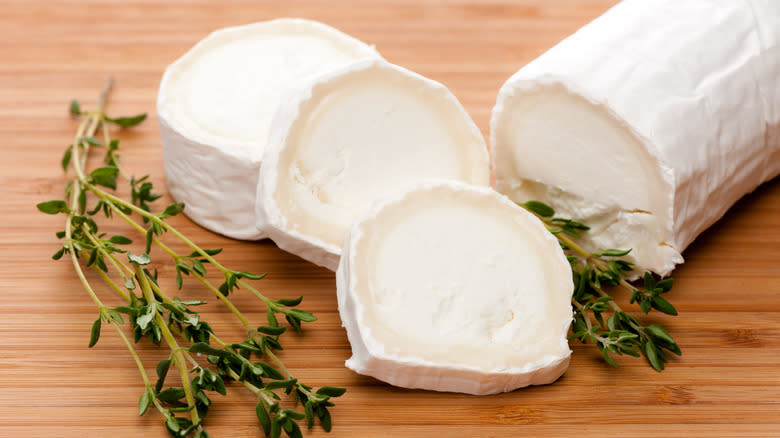
Goat cheese is made from goat's milk, but it's more than just another type of dairy milk. Also referred to by its French name, chèvre, goat cheese comes in textures from creamy to crumbles and features various flavors, often influenced by where the goat is pastured. Generally, goat cheese has a creamy texture and a lemony brightness that makes it feel rich in the mouth and utterly indulgent.
Because you're going for the ultimate in creamy mashed cauliflower, it's best to get goat cheese sold in rounds or even tubs instead of crumbles. Crumbles are delicious but can be dry and hard to blend. A tablespoon of Parmesan adds another layer of flavor, too. You'll also need to add some heavy cream or milk. Goat cheese is luscious but not particularly liquid and cannot bring that signature silky finish without a bit of help.
Be mindful that goat cheese can last a long time, and the flavor deepens as it ages, but it tends to dry out quickly. To properly store goat cheese to prevent drying out, wrap it in aluminum foil and store it in your fridge's dedicated cheese drawer.
Coconut Cream
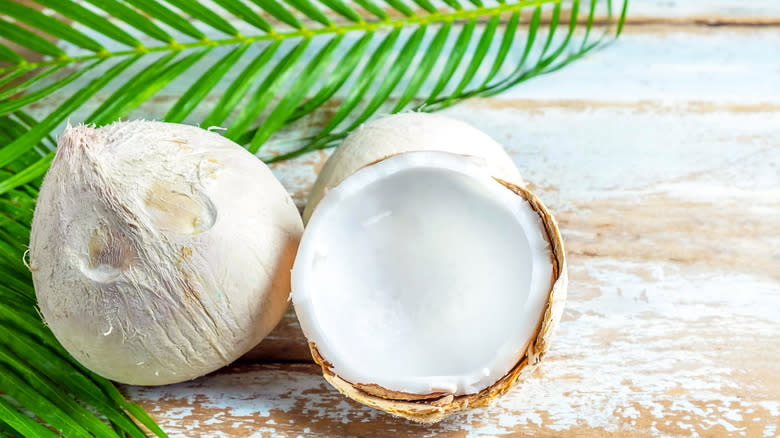
Coconut is a flavor typically associated with luscious desserts and tropical drinks, but it also has a place in cauliflower mash. This preparation is not for every palate or every meal, but coconut cream is another good dairy-free option for vegans or those who restrict dairy products for medical reasons. Coconut cream — that thick, solid layer on top of a can of coconut milk — is famous as a non-dairy substitute for whipping cream, but it also makes for a silky cream substitute.
To access the cream, place an unopened can of coconut milk in the fridge overnight. Open the can and scoop the thick, hardened cream off the top (reserve the liquidy milk underneath the cream for smoothies or just drinking straight). Blending cold coconut cream into hot cooked cauliflower is challenging, so heat the coconut cream gently until it becomes liquid, then process as you would regular cream.
Some people add a pinch of nutmeg and a big hit of freshly ground black pepper to embrace the mild sweetness and offset it simultaneously. While this flavor combination might not pair well with a roast turkey or a side of beef, think about adding this preparation to baked shrimp or other light dishes.
Mascarpone Cheese
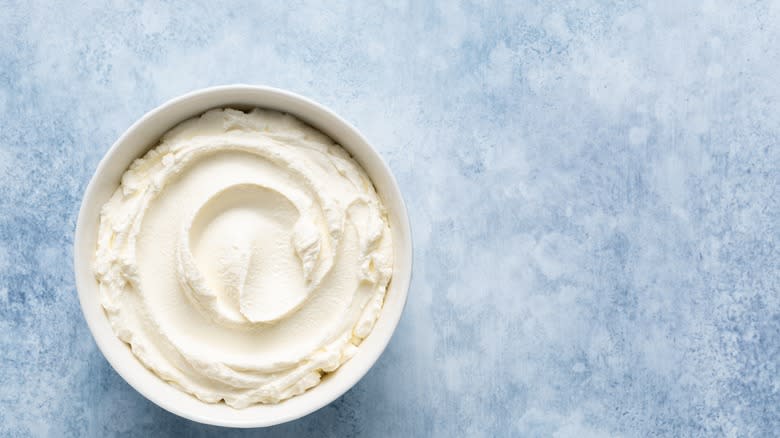
A decadent tiramisu gets its rich, indulgent texture from whipped mascarpone; this same luxurious texture can be your cauliflower mash's best friend, too. The subtle sweetness complements the cauliflower and even heightens its savory flavor, and the thick, silky feel of mascarpone is one of the best ways to get a creamy texture. When you want something thicker and richer than sour cream without its zingy snap, reach for mascarpone.
Mascarpone cheese cannot do the job alone. You'll need an equal amount of Parmesan and either milk or heavy cream (about two tablespoons each for a medium head of cauliflower) to add moisture and smooth out the cooked florets. For this preparation, use riced cauliflower quickly cooked in butter or boil florets until soft, draining, and patting dry when they are tender. Add mascarpone cheese, Parmesan, milk, and cauliflower to a blender and process until smooth. Season with pepper and prepare to be bowled over by the flavor and texture.
If you want to use mascarpone but would prefer to dial back the richness, you can substitute a little chicken stock or water instead of milk or heavy cream. The mascarpone cheese carries the flavor, and the liquid is there to add moisture. You won't miss the milk here.
Ricotta Cheese
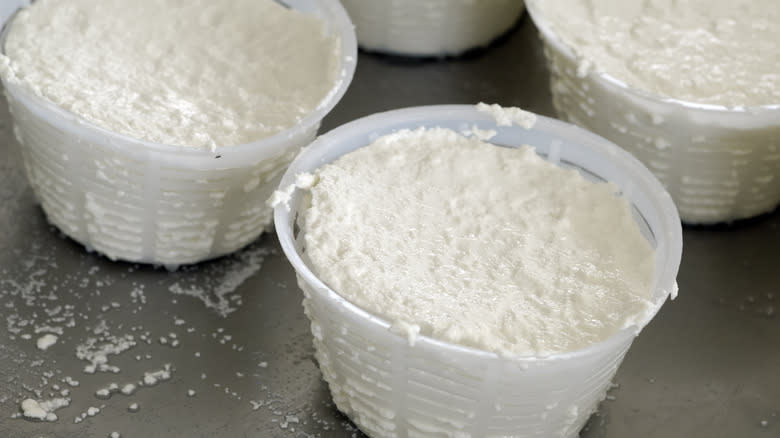
If you have ricotta cheese left over from making lasagna, you can use up a tablespoon or two of it to make cauliflower mash. Incorporating this fine, grainy cheese thickens up a watery mash and also keeps it light and fluffy, with a creaminess that keeps a bit of texture. Ricotta can also make this dish feel more substantial.
Like cottage cheese, ricotta is packed with protein and is a great way to add nutritional value to your cauliflower mash. Ricotta means recooked in Italian, a nod to its use of whey (a byproduct of cheesemaking). And true to its name, ricotta cheese is as easy to make as it is to buy. If you've got whole milk, a lemon, salt, and a little time, you can throw together ricotta in the time it takes to prep your cauliflower.
Have you tried all these additions and still can't get enough cauliflower? Grab a few more heads and try making roasted cauliflower mac and cheese, super-simple cauliflower rice, and sticky garlic cauliflower wings.
Read the original article on Tasting Table

